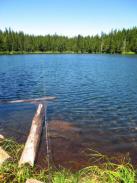Stocking your pond
To establish a balanced sportfish population, any existing fish must be removed from the pond or they will outcompete newcomers for food, cover and nesting sites. Next, select the best fish for your pond, and determine how many to stock and at what age or size, using the guide below.
- Coldwater fish: What to stock: Brook and rainbow trout are the most common coldwater sportfish; brown trout are can also be stocked but they are a more aggressive species and therefore less popular. When: Trout are best introduced in the fall when the water is cool. It’s generally advised to stock fingerlings (2-4 inches) into new or renovated ponds that are free of other fish. (If you’re planning to add fish to an established pond, consult a fisheries biologist.) How much: How many you stock (the “stocking density”) depends on the size of the pond; a good rule of thumb is 600 fingerlings per acre of surface area.
- Warmwater fish: What to stock: The most popular freshwater sportfish is the largemouth bass. It’s a predator and must be stocked with forage fish, most commonly bluegill (also known as bream or blue sunfish) or redear sunfish, both of which are also great to harvest. Channel catfish can be stocked alongside the bass and bluegill without affecting their populations. When: Bluegill is usually stocked in the fall or winter; and largemouth bass the following spring to give its prey time to mature. How much: To sustain the fish, you need to strike the right balance between predator and prey. The recommended stocking density is 100 bass fingerlings and 500 sunfish fingerlings per acre. Stock channel catfish at a density of 70 catfish fingerlings per acre.
- What not to stock: In small fish ponds, black and white crappies (speckled perch), yellow perch, pumpkinseed and green sunfish, bullheads (yellow and black) and gizzard shad are not recommended because they can become overpopulated, outcompeting your species of interest. Common carp and suckers tend to stir up the bottom, muddying pond water.
Ensure you’re stocking your pond with healthy fish by purchasing them from a licensed commercial fish hatchery (not by transferring them from local streams, rivers or lakes). Follow the hatchery’s advice on how to introduce fish to the pond because they are sensitive to new environments.
Before you stock, seek the advice of a fisheries expert in your state or county. They can help you determine what’s native to your region. Stocking non-native fish poses a threat to waterways that are connected to your pond or close enough to be affected by a flood.
Lastly, don’t overstock--overcrowding will actually reduce the overall fish population.
Enhancing the catch
Fertilizing and liming, artificial feeding, adding structure and establishing aquatic plants are all ways of managing fish populations in a pond.
- Fertilizing and liming: Inorganic fertilizers can be used to boost the supply of phytoplankton and zooplankton at the bottom of the food chain. But they can also have undesirable consequences, such as boosting the growth vegetation and algae. Liming -- the addition of limestone (calcite) -- increases the alkalinity and hardness of pond water. By neutralizing and reducing the levels of toxic metal dissolved in water, it helps promote healthy fish populations.
- Artificial feeding: Fish food, in the form of pellets, is the most direct way of increasing fish size without affecting the whole ecosystem. Feeding works best in ponds under five acres.
- Structures: Fish shelters help concentrate swimmers but they also provide much-needed cover, resting spots and feeding areas. They can be natural or man-made, including sunken Christmas trees, logs, pipes and concrete blocks.
- Aquatic plants: They’re essential to ecosystem, providing vital food and cover, but they can quickly get of hand. They can be managed mechanically, chemically or biologically. Grass carp can uesd to control noxious weeds in ponds. These herbivores are sterile so they must be restocked.
Fishing your pond
Pond fish are a renewable resource if the populations of predatory and forage fish are kept in balance by proper harvesting. But the importance of harvesting is often overlooked. Basically, your goal should be to fish enough to keep populations in check. Recreational fish ponds are usually underfished, leading to overpopulation and a host of related problems, such small, stunted fish.
A balanced ponds is one in which the fish are of a harvestable size, reproduce annually and coexist with other species, including a predator species. Regular harvesting, sampling of the fish population by angling or seining, and recording the catch (weight and size) are all helpful management practices.
Warmwater fish:
When to fish: In a pond stocked with largemouth bass and bluegill, you can begin harvesting the following summer, once the fish have had a chance to reproduce. (Largemouth bass reproduce once a year in spring; bluegill reproduce several times per year.) However, you may wish to wait until the third year, or until bass have grown to 12 to 14 inches in length. Spread the harvest throughout the year.
How much to catch: Follow these guidelines for unfertilized and fertilized ponds.
- Bluegill: unfertilized: 40-50 lbs/acre/year; fertilized: 100-125 lbs/acre/year.
- Largemouth bass: unfertilized: 10 lbs/acre/year; fertilized: 25 lbs/acre/year.
- Channel catfish: harvest and restock as needed; they reproduce poorly in fish ponds.
Coldwater fish:
Trout may not survive the summer, when water temperatures rise above 70 degrees, so fish for them through the winter and spring.
More Pond Resources
- At Home with Wetlands - A Landowner's Guide from the state of Washington's Department of Ecology.
- Online Videos on Pond Management from Texas A & M
- Managing Small Fishing Ponds and Lakes in Tennessee Publication
FAQs about Pond Management from
How can I get more tips?
It’s simple! Enter your email below.


